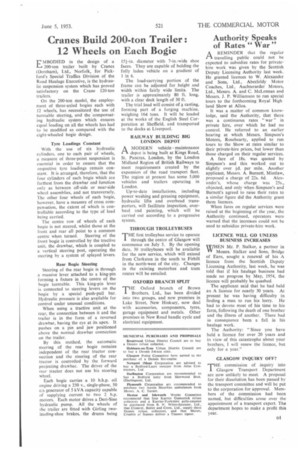Cranes Build 200-ton Trailer: 12 Wheels on Each Bogie
Page 41

If you've noticed an error in this article please click here to report it so we can fix it.
EMBOD1ED in the design of a 11-1 200-ton trailer built by Cranes (Dereham), Ltd., Norfolk, for Pickford's Special Traffics Division of the Road Haulage Executive, is the hydraulic suspension system which has proved satisfactory on the Crane 120-ton trailers.
On the 200-ton model, the employment of three-axled bogies each with 12 wheels, has necessitated. the use of turntable steering, and the compensating hydraulic system which ensures equal loading on all the wheels has had to be modified as compared with the eight-wheeled bogie design.
Tyre Loadings Constant
With the use of six hydraulic cylinders, one to each pair of wheels, a measure of three-point suspension is essential in order to ensure that the respective tyre loadings remain constant. It is arranged, therefore, that the four cylinders of each bogie which ale farthest from the drawbar end function only as between off-side or near-side wheel assemblies, and not transversely. The other four wheels of each bogie, however, have a measure of cross compensation, the extent of which is controllable according to the type of load being carried.
The centre row of wheels of each bogie is not steered, whilst those at the front and rear all point to a common centre when turned. Steering of the front bogie is controlled by the tractive unit, the drawbar, which is coupled to a vertical steering post, operating the steering by a system of splayed levers.
Rear Bogie Steering
Steering of the rear bogie is through a massive lever attached to a king-pin forming a fixture in the centre of the bogie turntable. This king-pin lever is connected to steering levers on the bogie by a special push-pull bar. Hydraulic pressure is also available for control under unusual conditions.
When using a tractive unit at the rear, the connection between it and the trailer is in the form of a reversed drawbar, having the eye at its apex. It pushes on a pin and jaw positioned above the normal drawbar connection on the trailer.
By this method, the automatic steering of the rear bogie remains independent of the rear tractor connection and the steering of the rear tractor is controlled by the forward projecting drawbar. The driver of the rear tractor does not use his steering wheel.
Each bogie carries a 10 b.h.p. oil engine driving a 230 v., single-phase, 50 cis generator of 5 kVA capacity capable of supplying current to two 2 h.p. motors. Each motor drives a Den-Sine hydraulic pump. All the wheels of the trailer are fitted with Girling twoleading-shoe brakes, the drums being
151-in. diameter with 7-in.-wide shoe faces. They are capable of holding the fully laden vehicle on a gradient of 1 in 6.
The load-carrying portion of the frame can be adjusted for height and width within fairly wide limits. The trailer is approximately 80 ft. long, with a clear deck length of 30 ft.
The trial load will consist of a casting, forming part of a forging machine, weighing 164 tons. It will be loaded at the works of the English Steel Corporation at Sheffield, and transported to the docks at Liverpool.
































































































